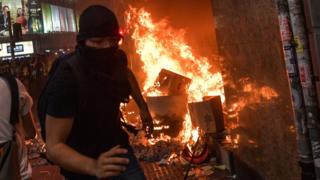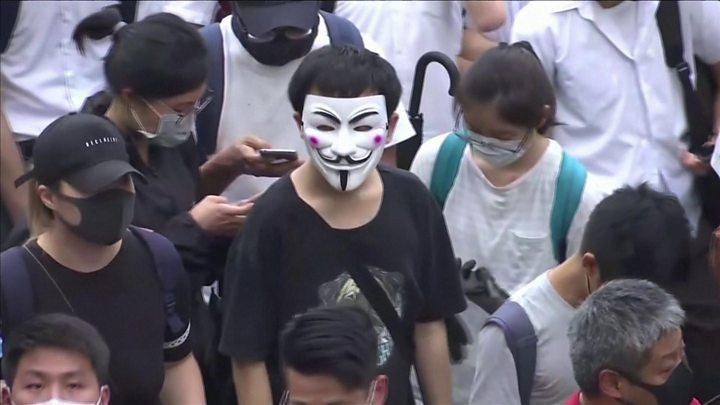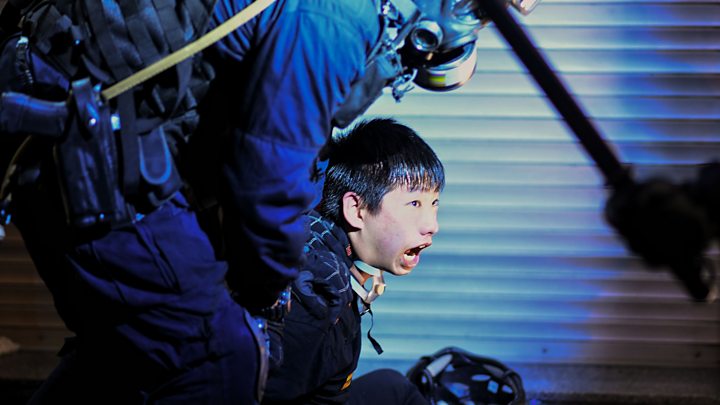Hong Kong: Face mask ban prompts thousands to protest
Thousands join unplanned protests after the government announced a face mask ban from midnight. …

 Image copyright AFP/Getty
Image copyright AFP/Getty Thousands have joined unplanned protests in Hong Kong after the territory’s government announced a face mask ban, effective at midnight (16:00 GMT).
Chief executive Carrie Lam invoked a colonial-era emergency law in a bid to quell months of anti-government unrest.
The ban comes after an escalation of violence during protests on 1 October, when an officer shot a demonstrator.
Protesters immediately took to the streets after the ban was announced.
Many left work early to join the spontaneous demonstrations. Some furious protesters blocked roads, torched Chinese flags and vandalised stations and businesses, as police fired rounds of tear gas.
The territory’s Mass Transit Railway (MTR) announced a full service suspension of all buses and trains. A spokesman told the BBC this was due to vandalism and attacks on staff.
Mask-wearing activists had also earlier called on others to wear masks in defiance of the government, which critics fear is becoming increasingly authoritarian.
Ms Lam said she was forced to implement the colonial-era law because the violence at the now-weekly protests was “destroying the city”, and she could not allow the situation “to get worse and worse”.
The end of anonymity
Danny Vincent, BBC News, Hong Kong
Angry protesters marched and chanted through the heart of this financial hub. They ripped down a banner marking 70 years of communist rule, setting it alight in front of a cheering crowd.
Hundreds wore masks in defiance of the ban.

Media playback is unsupported on your device
Today will be the last time demonstrators can hide their faces legally. Anonymity has become a key part of this movement but many fear that the introduction of this emergency law could lead to further restrictions.
This protest movement began in opposition to a now withdrawn extradition bill. Today’s passing of the emergency law did not need to go through the legislative body.
Carrie Lam insists that the territory is not in a state of emergency, but the law would allow her to take further emergency measures.
What’s been the reaction to the ban?
Observers say the regulation will be hard to enforce and hugely controversial: critics have warned the mask ban could be the first in a series of “draconian” measures.
“This is a watershed. This is a Rubicon,” pro-democracy lawmaker Claudia Mo told news agency AFP. “And I’m worried this could be just a starter. More draconian bans in the name of law could be lurking around the corner.”
The announcement has also prompted reaction from further afield, with Marta Hurtado, the United Nations human rights spokeswoman, noting at a news conference in Geneva that “any restriction must have a basis in law and be proportionate and as least intrusive as possible”.
UK Foreign Secretary Dominic Raab, meanwhile, has said “political dialogue is the only way to resolve the situation”.
Where does the ban apply?
The ban will apply for approved and unapproved public assemblies – rallies and marches – as well as in unlawful assemblies and riots.
The ban covers all kinds of facial covering, including face paint. Protesters have increasingly worn masks for a number of reasons, including to conceal their identities – from employers, parents and, in some cases, police – and to protect themselves from tear gas.
There are exemptions for people wearing masks for health reasons, or if required by their profession.
Ms Lam said “violence had been escalating to alarming levels” leading to a situation of “chaos and panic” in the city.
What is the Emergency Regulations Ordinance?
The legislation invoked by Ms Lam, called the Emergency Regulations Ordinance, dates to 1922 and has not been used in more than 50 years.
It enables the chief executive to bypass the normal legislative process, where bills have to go through the city’s parliament, the Legislative Council.
The ERO was last used in 1967 to help stop riots in the territory’s trading hub.
Ms Lam stressed the new regulation did not mean that Hong Kong was in a state of emergency. But she said the city was “in a state of serious public danger”.
What is the background?
Hong Kong’s protests started in June, sparked by proposals to extradite suspected criminals to mainland China.
The extradition bill has since been cancelled but protests have widened into pro-democracy and anti-police demonstrations.

Media playback is unsupported on your device
Over the months, clashes between police and activists have become increasingly violent. On Tuesday, police shot a protester in the chest with a live bullet for the first time.
Authorities say the 18-year-old – who was attacking police and was arrested after being shot – is in a stable condition in hospital.
Hong Kong is a former British colony handed back to China in 1997.
It has a “one country, two systems” agreement that guarantees it some autonomy, and its people certain freedoms, including freedom of assembly and freedom of speech.
But those freedoms – the Basic Law – expire in 2047 and it is not clear what Hong Kong’s status will then be.




